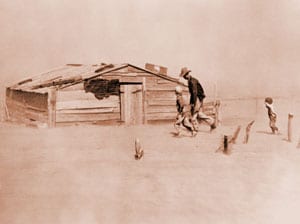
dust storm in Cimarron County, Okla., April 1936.
In the 1930s Oklahoma was included in a roughly-defined geographic area and cataclysmic environmental event known jointly as the Dust Bowl. Climatic events, farming techniques and governmental policies combined to create the disaster of the Dust Bowl. Long droughts allowed high winds to blow unprotected soil into clouds of dust so thick they blotted out the sun. Valuable topsoil blew away making it nearly impossible to grow crops. People and animals choked on the dust and suffered and even died. Ironically, the Dust Bowl was a time of some of the most devastating flood events in the state, with no plant life in place to hold back the water when rain did come. Many moved away from Oklahoma and the area worst affected.
In February 1937 President Franklin D. Roosevelt sent to all states a model law that would allow a referendum of landowners and operators to create soil conservation districts. Soil conservation districts would allow local people to set priorities and make decisions about practices to conserve soil and water resources. Technical assistance would be provided by a federal agency originally created as the Soil Erosion Service in 1933, renamed as the Soil Conservation Service in 1935 and today are known as the Natural Resources Conservation Service, an agency within the U.S. Department of Agriculture.
In April 1937 Oklahoma passed the Conservation District Enabling Act, giving citizens the opportunity to form their own conservation districts. The same Act created the agency known today as the Oklahoma Conservation Commission.
Today the entire state is divided into conservation districts, usually, but not always, along county lines. A five-member board of directors guides each district, three of which are elected by area voters and two are appointed by the Oklahoma Conservation Commission based on local board recommendations.
Conservation districts are legal subdivisions of state government, whose primary goal is to assist citizens in practicing wise use and management of the state’s renewable natural resources, especially its soil and water. Conservation districts continue to assist farmers and ranchers as in the past, but today also assist a larger segment of the public including community planners, public health officials, developers and rural and urban citizens. Districts also provide a variety of education materials and opportunities for students.
The Oklahoma Conservation Commission is the agency that provides assistance and guidance to the state’s conservation districts and helps coordinate their activities. In addition, the Conservation Commission is the lead state agency for soil conservation and erosion control and for upstream flood control programs. The Conservation Commission administers the state program for reclaiming abandoned mine land and the state Conservation Cost-Share Program and coordinates environmental education with other state agencies. The Conservation Commission is also the lead technical agency in the state for nonpoint source water quality programs of the U.S. Environmental Protection Agency and is responsible for maintaining a geographic database for citizen-filed pollution complaints gathered from all state agencies.